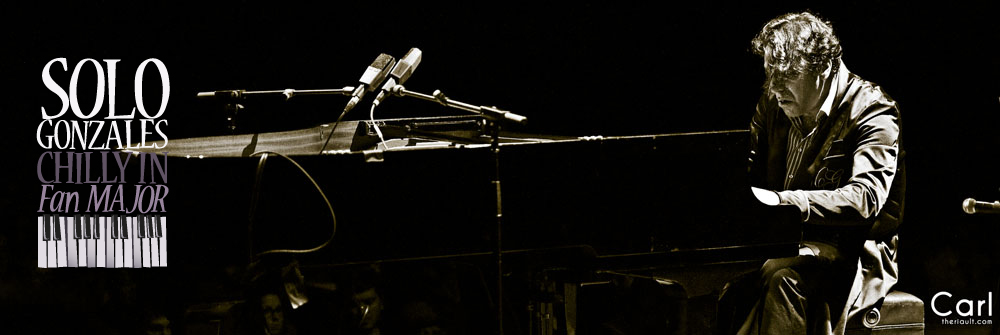Solo Piano II Tour in PianoVision
Toronto – Nov 8th, 2012 8:00PM
Winter Garden
Good concerts are fun to attend, and provide a few hours of entertainment along with some happy memories. Great concerts, on the other hand, can change you as a person. They permeate your being and release adrenalin and endorphins similar to a drug, and these feelings can return just by recalling the concert. Chilly Gonzales has great concerts, and Toronto was one of his best. Sharp and bright-eyed, Gonzales’ was in top form on Sunday, with seeming a seemingly effortless performance that was undoubtedly some of the best and most passionate piano playing the seasoned crowd had witnessed.
The Venue
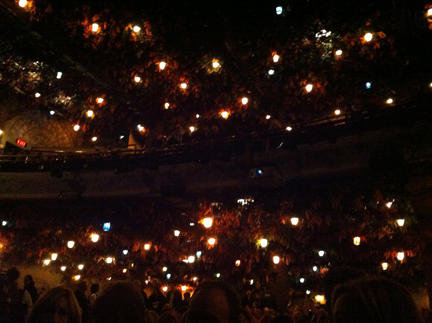
There was a distinct feeling of excitement in the theatre. Maybe it was Feist making the rounds with friends and family, or it could have been Toronto’s “captains of industry” discussing the latest business news. Whatever it was, it pervaded the lush Winter Garden. The Winter Garden is a unique venue. The exterior facade of the building is very unassuming, but once inside, one realizes just how special it is. Patrons travel up four sets of stairs and escalators, with heighted anticipation on each level. After the long journey, the audience is transported into a scene from a large garden party. A tree stands at the back, with its leaves dangling from wall to wall throughout the venue, and hanging from the branches are small coloured incandescent lights cast a soft glow throughout as if someone hung thousands of candle-lanterns within the venue. The ornately painted ceiling is reminiscent of an outdoor party just after dusk, with long red-laden light rays basking the audience on a warm summer night.
The crowd was accurately described on Twitter as ‘aging hipsters’. The variance between Gonzales Montreal and Toronto shows is amazing. Montreal draws a young, passionate crowd, where Toronto draws an older appreciative crowd. It would seem that somehow, Gonzales has captured the widest demographic of any entertainer working today. Marketing agencies would be literally sell their souls to appeal to such a wide audience!
Kenaston
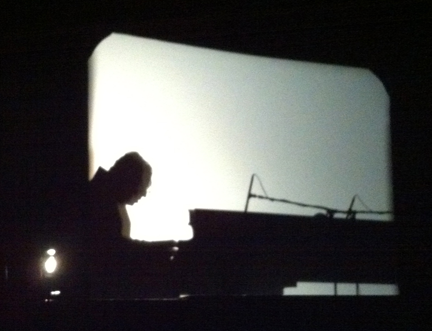 One unique feature of the concert was that there was no piano in sight. Instead, a large canvas obscured centre stage. Twenty minutes after start time, the lights are dimmed, and a piano begins to softly play. The screen’s purpose became apparent as a light from behind the piano and Gonzales projected a distinct shadow onto the screen. A curl of hair, mouth agape, and trademark robe and slippers – all configured to mimic the intimate Solo Piano II cover perfectly. The opener, Kensaton, with its incredible warmth and melancholy seemed to be Gonzales personal welcome to every member of the audience as if to invite everyone to gather around the piano in the living room of his childhood home. Kenaston (the street where he spent his first years in Montreal), evokes images of innocence and playfulness, and marks the passing of time – not only for ourselves, but memories of our children and grandchildren as well.
One unique feature of the concert was that there was no piano in sight. Instead, a large canvas obscured centre stage. Twenty minutes after start time, the lights are dimmed, and a piano begins to softly play. The screen’s purpose became apparent as a light from behind the piano and Gonzales projected a distinct shadow onto the screen. A curl of hair, mouth agape, and trademark robe and slippers – all configured to mimic the intimate Solo Piano II cover perfectly. The opener, Kensaton, with its incredible warmth and melancholy seemed to be Gonzales personal welcome to every member of the audience as if to invite everyone to gather around the piano in the living room of his childhood home. Kenaston (the street where he spent his first years in Montreal), evokes images of innocence and playfulness, and marks the passing of time – not only for ourselves, but memories of our children and grandchildren as well.
Kenaston is impossible to describe as no words can measure up to the emotion and imagery one experiences when hearing the song; and it is all the more powerful when played live from the composer’s hands. One wonders if this is what audiences experienced upon hearing Rachmaninoff or Rubenstein play live.
Rideaux Lunaires
Kenaston eventually gives way to “Rideaux Lunaires”, which literally translates to “Moon Curtains”. The lilting melody from the upper octaves is gentle and light, like a moonlit breeze on a warm summer’s night. This piece in particular suited the venue perfectly. The live version diverges from the album version in that it delves into a more complex mid-register ‘bouncing’ harmony, which is still light-hearted, but supplies an element of tension. The resolution is in the form of a shift into the steel-drum inspired “Othello”.
Othello
Othello was the first pre-release off Solo Piano II. With alternating percussive chords and legato melodies and lush chords, Othello is reminiscent of a Samba or other Latin-American rhythm. Written as homage to Othello Molineaux (the famous steel drummer), the steel drum effect on the piano is very convincing. Partway through the song, Gonzales employs the piano fallboard as a percussive device, snapping it back to add rhythm (this draws a few chuckles from the audience). Throughout the opening songs, the audience is dead silent, with everyone simply letting the music wash over them and elicit personal emotions and memories.
Minor Fantasy
Othello turns sharply into “Minor Fantasy”, which is literally an about face musically. While Othello is bouncy and full of life, Minor Fantasy is the type of song you might imagine played in a dark and lonely bar. Its ominous bass notes hang in the air, foretelling what the future has in store for poor souls. Twinkling notes from the upper-octaves tease, before coming crashing down into the dark reality of life. Gonzales hammers out the foreboding melody with such force that the Steinway literally throws wisps of smoke into the air, as if he has awoken deep and unused recesses of the piano from a long slumber. In the end, a single chord is held until the vibrational energy of the strings dissipates and is absorbed by entire room; people, leaves, and all.
Arpeggio Lesson
After the audience has ensured that Gonzales has truly finished playing, they begin to clap, heightening quickly to thunderous applause. Always gracious, Gonzales breaks into a wide smile, nods politely, and responds with his trademark, “Thank-you-so-much”, squinting, his eyes scan the audience as if to identify people and gauge their reaction. After a curt introduction, Gonzales proceeds to impart some wisdom to the audience in the form of a music lesson on arpeggios. If anyone has followed Gonzales career for any length of time, you soon realize that he loves to share his knowledge and talent. Most of his shows include several humorous insights into music, which are eventually parlayed into subjects as diverse as politics and world peace!
As an aside, the word arpeggio is derived from the Italian word for harp: arpa. Arpeggio is a style of playing reminiscent of picking harp strings one at a time to build up chords with a particular rhythm. The modern-day use of the word includes ‘ arpeggiator’, which is a function of many synthesizers to play distinct sequences of notes over and over as a way of providing an underlying percussive-like ‘glue’ to the main harmonies.
Gonzales’ humorous example displayed the difference between using arpeggiated chords and straight chords when playing a song such as “In the Mood” by Glen Miller. One is a dynamic dance number, the other a soulless sequence of disconnected chords. Gonzales also gave a brief demonstration of arpeggiated notes by playing a sequence from Daft Punk’s “Aerodynamic”. Gonzales sums up arpeggios as, “The poor man’s way to get to rhythms.” All of the arpeggio explanations eventually led to Gonzales’ “Train of Thought”, complete with double-arpeggios. Gonzales demonstrated what each hand’s ‘job’ was in Train of Thought; the left hand plays an ascending arpeggio, while the right hand plays an equal, but descending arpeggio. Gonzales goes on to explain that the arpeggiated chords alternate between G Major and “The Hitchcock Chord” (Eb minor6). Together, the interplay between the arpeggiated chords creates “question and answer” or “tension and release”, which are concepts central to all music. Gonzales proceeded to play the ‘album’ version of Train of Thought, which really ties the piano together with a ‘human’ sequencer to produce a song that has an inherent rhythm, but also the lush harmonics of a piano that synthesizers have not been able to emulate.
During the demonstration, the large PianoVision screen (which stretched across the entire stage) allowed the entire audience to see exactly how Gonzales played each and every note. PianoVision is very effective at immersing the audience’s visual field with the speed and dexterity that Gonzales moves between notes, though few in the audience would be able to imitate what they were witnessing.
Even more impressive was that Gonzales had an ‘entertainers’ version of Train of Thought. As impressive as the album version is, the entertainer’s version was absolutely mind-boggling. The PianoVision system would have to be equipped with high-speed cameras in order to capture individual finger movements! All that was displayed was a blur of fingers madly moving between keys as if Gonzales had somehow been able to trick his body into accurately playing at blinding speed for any length of time. In the end, the entertainer’s version of Train of Thought gave way to thunderous applause.
Escher
Gonzales’ next lesson revolves around the differences between art and entertainment: European versus North American musical tastes. The next song (Escher) is then played in two styles. Escher is named after the famous illustrator because the left hand melody reminded Gonzales of someone going up and down a staircase leading nowhere. First, the European “aristocratic” version, complete with trills and other adornments, sounds light and “full of space”. Next, the same song has a “North American” accent applied, which changes the left hand accompaniment into a powerful disco banger – much to the delight of the audience. The interplay is wonderful, with effortless cadenzas alternating with light-hearted chords. Then the mood turns darker, and Gonzales begins to literally jump out of his seat as if to direct all of his energy to the choppy passages, finally cumulating with an energized sequence in the lower registers that the audience can physically feel. The chaos again gives way to the light-hearted upper register notes. The original light melody returns, but now seems even lighter due to the contrast with the harsh bass notes (which still seem to resonate long after they were abused). Finally, the pressure gradually increases and ends off with a beautiful flourish. Again, the audience breaks out into applause and cheers.
To have a sense of how much more dimension Gonzales adds to the live songs, compare the following excerpts of “Echer”. First, the ‘Aristrocratic’ album version from Solo Piano II:
Escher Solo Piano II (excerpt)
Next, the dynamic, live ‘Americanized’ version from Toronto:
Escher Live in Toronto (excerpt)
The difference is striking, and it’s a real pleasure to witness Gonzales ‘morphing’ songs for his live shows.
Self Portrait/ Supervillain Music
The next section of the concert draws from “The Unspeakable Chilly Gonzales”. As Gonzales starts rapping to “Self Portrait”, he asks if there are any rap fans in the audience. From the response, it appears that a large portion of the audience enjoys rap. Self Portrait never really ends up as a completed number. Instead, Gonzales explains how he was able to draw inspiration from rap and find parts of rap that he can bend and use in his own unique way. In the end, Gonzales asks if the audience believes that he can rap over a 6/8 time signature. The answer is, “of course I can!” as he dives into Supervillain Music.
Beans
Of all the songs Gonzales played, Beans drew the most laughs by far. Lyrically and harmonically rich, with an ‘essence’ of Elvis, the crowd became animated and relaxed.
As an aside, comedy and virtuosity are characteristic of Gonzales’ live style: his ability to make you roll with laughter one second, and then punch you in the gut with deep emotional harmonies the next. Like a boxer setting up his opponents for the old ‘one-two’, the audience is more than happy to be sucker punched a few times!
Piano Lesson (Improvisational Song)
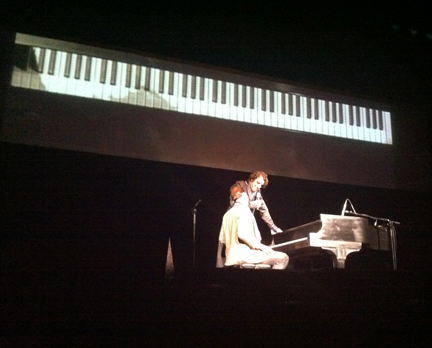 One of the mainstays of a Gonzales show is the piano lesson. Lapsed piano students abound, and there’s something about Gonzales’ playing style, music and persona that motivates many to take up the piano yet again. Gonzales invites these individuals onto the stage to partake in a piano lesson of sorts.
One of the mainstays of a Gonzales show is the piano lesson. Lapsed piano students abound, and there’s something about Gonzales’ playing style, music and persona that motivates many to take up the piano yet again. Gonzales invites these individuals onto the stage to partake in a piano lesson of sorts.
Gonzales, hand over brow, squints and scans the audience as he searches for a willing (and suitable) volunteer. After dismissing a few individuals for being ‘too giggly’ (he would have sent them back anyway), his eye catches a well-dressed and handsome man. Dressed in a tweed jacket and school scarf, the man’s dirty blond hair is slicked back to complete an effect of pure sophistication. Gonzales indicates that he smells the ‘beans’ on this individual, and proceeds to dub him ‘Gatsby’ (after the Great Gatsby). It turns out that Gatsby did take piano lessons, but turned his attention to ‘books’. With this, Gonzales shoots the audience his best ‘straight-man’ face, then proceeds to utter a single word – ‘respect’. At this point, the audience is beside themselves with laughter.
In the end, Gonzales and Gatsby produce a very pleasant and likeable piano piece, with Gatsby providing the right-hand melody, and Gonzales drumming out a constant rhythmic accompaniment that somehow matches perfectly with whatever Gatsby is playing. After a few changes between white and black keys, a frenetic finale ensues, and the audience roars with applause and cheers. A handshake and solid hug later, and Gatsby is back in his seat, flush with the experience of having a piano lesson with a true master.
To top it all off, after the audience settles back down, Gonzales plinks out Gatsby’s chosen melody, and then makes a contemplative gesture as if to say, “not bad … I could use that”, much to the delight of the audience!
Dot
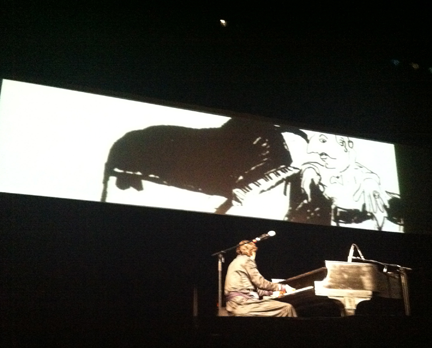 Always an audience favourite, Dot is a great example of how a Gonzales song evolves over time. What started out on a wonderfully simply melody, end up as a frenetic, energized, seven minute version that leaves no key untouched. Simultaneously, the PianoVision screen plays out a battle scene between a pianist and an anthropomorphic ‘bull’ piano. The two battle it out, and in the end, the pianist and piano become one in some sort of twisted Greek myth. The effect is reminiscent of silent movies, with the music providing a wonderful soundtrack as the battle is waged. The venerable Dot eventually is hammered out at lightning speed, and with such force and voracity, that it’s comforting to know that Steinway tests each key by slamming a leather-encased iron weight down on it! PianoVision returns, but focuses on the left hand action as a disharmonious beat is literally pounded out to the point that the entire piano vibrates with energy, not unlike a hammer hitting a sheet of metal. Returning to the frenetic pace, the tempo of Dot increases until after a few final mashes of the bass notes, a single high-register key provides the final period. Immediately, the crowd cheers and applauds loudly for the spectacle that they just witnessed.
Always an audience favourite, Dot is a great example of how a Gonzales song evolves over time. What started out on a wonderfully simply melody, end up as a frenetic, energized, seven minute version that leaves no key untouched. Simultaneously, the PianoVision screen plays out a battle scene between a pianist and an anthropomorphic ‘bull’ piano. The two battle it out, and in the end, the pianist and piano become one in some sort of twisted Greek myth. The effect is reminiscent of silent movies, with the music providing a wonderful soundtrack as the battle is waged. The venerable Dot eventually is hammered out at lightning speed, and with such force and voracity, that it’s comforting to know that Steinway tests each key by slamming a leather-encased iron weight down on it! PianoVision returns, but focuses on the left hand action as a disharmonious beat is literally pounded out to the point that the entire piano vibrates with energy, not unlike a hammer hitting a sheet of metal. Returning to the frenetic pace, the tempo of Dot increases until after a few final mashes of the bass notes, a single high-register key provides the final period. Immediately, the crowd cheers and applauds loudly for the spectacle that they just witnessed.
Young Piano Lesson (Bongo Monologue)
For Gonzales’ second piano lesson, he sought out a young member of the audience. After dismissing a few people as being too old, his eye catches a young girl bouncing up and down. After she clambers onto the stage, Gonzales finds out that her name is Charlie. After settling down on the piano seat, Gonzales asks Charlie what sort of music she likes. As Charlie is contemplating an answer, Gonzales exclaims, “You like bongo rap? What a coincidence!” and he proceeds to produce a set of bongos from behind the piano. After a brief lesson on which keys to press, Gonzales starts into Bongo Monologue. Charlie appears to be about 11 or 12 – an age of innocence, which is why the audience let out a collective gasp when Gonzales drove into the lyric, “My brain’s fucked, cause my dick is thinking”. Oh, poor Charlie’s ears! Actually, most children learn all the ‘choice’ words and phrases by about 7, so Charlie could have just as easily laid down a string of profanities that would make Gonzales blush! After a cordial Harper-like handshake, Charlie went on her merry way, with a juicy tale to tell the kids in her class the next day.
White Keys
Gonzales often mentions the limitations of the piano – the inability to change a note once it has been struck, etc. Glenn Gould once said that although he didn’t have a great love for the piano, but it was the best vehicle he had to express his ideas. The ability to Gonzales to seemingly effortlessly create a circuit from his thoughts to the energy of the piano is nothing short of extraordinary. In order to keep the piano interesting, Gonzales invents different ‘rules’ or ‘challenges’ for some songs. White Keys is one of those songs. After all his talk of the pomposity and racism of major chords and white keys, Gonzales strives to contradict himself and creates a lush melody full of harmony using only the white keys.
The main element is an interplay of short left and right hand arpeggios, with the occasional reach to a higher key. Almost as if a finger occasionally escapes to shine for a brief moment, but is quickly drawn back into the fold and continues with the rhythm. Occasionally, his fingers take a stroll down the keyboard, only to land on the same rhythm. The effect is beautiful and mesmerising (and not racist in the least).
At one point, Gonzalaes’ right hand reaches higher and higher through the keyboard until finally striking C8. After that, he strikes the edge of the piano as if to curse its physical limitations! For Gonzales, the piano seems to stretch much further mentally than it physically does.
The Grudge
Gonzales loves to impart nuggets of wisdom onto the audience, not only regarding piano technique and history, but real-world life lessons as well. Everyone is inspired by individuals at one point or another, but it is usually assumed that the individuals who inspire you do so in a positive manner – role models, so to speak. There is another type of inspiration that one can receive from negative individuals as well. One of envy and jealousy – as long as that envy is used positively, it can be a great motivator. Gonzales explains that as he scanned the guest list, he noticed a familiar name from his childhood – someone who certainly fell into the category of “motivation through envy”, and Gonzales was basking in the glory that while he was on stage reviling in adoration, the other individual was in the audience -nameless and faceless. As Gonzales dedicated the Grudge to this nameless, faceless individual, the theatre went dark (including all stage lights), and a spotlight shone brightly on a single seat, to cleverly identify this individual from his youth. It was a wonderful setup, and had the audience cackling with laughter. After the show, the individual was defending himself and indicated, “But I’m only 16 – it’s mathematically impossible that I knew Gonzales then.” Sure it is.
Singalong
Another song that audience look forward to is Singalong. During singalong, the entire audience is asked to produce a guttural hum (like Ol’ Dirty Bastard), in the form of an ostinato. Gonzales explains that an ostinato is a short repeated sequence of bass notes that is used in almost every dance song today. As Gonzales plays the notes to sing and guides the audience through a few test cycles, he begins his piano accompaniment. The piano playing is bluesy and jazzy, with an element of improvisation that is unlike many other of Gonzales’ songs. He asks the audience to change their vocal style – to make the humming more emotional, and then more powerful. The overall effect is not only beautiful musically, but rather cathartic, as if one is extracting stress and sending it out as vocal energy.
In the end, Gonzales performs wild slides and improvisations on the piano, cumulating in a controlled fury of chords and notes, while the audience applauds, whistles, and hollers wildly.
Spontaneous Standing Ovation
Gonzales mentioned that his secret weapon is beautiful harmonies, and that he delivers that payload by opening up people’s minds with humour. It would seem that the audience also has a secret weapon – adoration. After the Singalong, there was thunderous applause, then several members of the audience stood up, and the rest soon followed. At first, Gonzales replied in his usual polite manner, but as the applause and standing ovation continued, he sat down and alternated his gaze between the audience and the keyboard. When he looked up, he was glassy-eyed – obviously touched by the audiences’ show of affection and appreciation. It seemed as if he was trying to capture the moment and, for a brief moment, allowed himself to be swallowed by the audience.
Evolving Doors
Possibly motivated by this spontaneous gesture, Gonzales proceeded to play a beautiful rendition of “Evolving Doors”. Possibly Bach-inspired, Evolving Doors starts off with incredible interplay between right and left hands, similar to drumming, but far more complex. The mood of the song alternates between light-hearted quick and bouncy rhythms, and frantic left/right sequences that travel across the bottom half of the piano. The lighthearted parts are full of wonderful embellishments: trills, grace notes, and mordents that adorn the song and bring another level of sophistication and complexity. Midway, Gonzales moves to the upper registers of the piano and plays dreamy harp-like sequences before moving back to the middle registers and re-building tension. Resolution comes quickly with a staccato jaunt across the keyboard in the final few moments.
It appears as it the audience was caught slightly off-guard as Gonzales quickly thanked the audience, wished them goodnight and exited the stage. Immediately,the entire venue started cheering and clapping, determined to see and hear just a bit more of Gonzales.
Encore
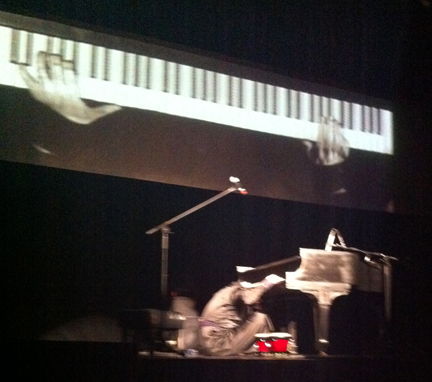 After the audience has clapped and cheered for a few minutes, Gonzales re-appeared on stage, towel draped over his neck, to give the audience one last thrill – under piano playing. There are many blind or nearly-blind piano players, so it should come as no surprise that one can play the piano without looking at the keys. It is, however, a completely different matter to play the keyboard from under the piano. As Gonzales asked the audience “let’s all sit”, he took his place under the piano, legs crossed (to reach the pedals), and head bowed. The angle that your wrists bend in order the play the keyboard and reach the keys from this position is uncomfortable, to say the least, and to flawlessly play three selections is an incredible feat.
After the audience has clapped and cheered for a few minutes, Gonzales re-appeared on stage, towel draped over his neck, to give the audience one last thrill – under piano playing. There are many blind or nearly-blind piano players, so it should come as no surprise that one can play the piano without looking at the keys. It is, however, a completely different matter to play the keyboard from under the piano. As Gonzales asked the audience “let’s all sit”, he took his place under the piano, legs crossed (to reach the pedals), and head bowed. The angle that your wrists bend in order the play the keyboard and reach the keys from this position is uncomfortable, to say the least, and to flawlessly play three selections is an incredible feat.
The final selections were a melody of Gogol, Overnight, and Armellodie – all favourites from the original Solo Piano.
As he stood up and stretched, he bowed, and graciously thanked the audience several times. With one last wave, his formidable green slippers took him behind the stage curtain.
Final Thoughts
If you examine the Solo Piano II cover, it is as if we are peering into Gonzales’ private piano room and observing a recognizable silhouette composing in front of a piano that has been completely opened. The message is that Solo Piano is truly that – something deep and personal for every listener. The sound is laid bare – there’s nothing to hide. Vladimir Horowitz once said that the loneliest place in the world was on stage in front of the piano. It appears to be quite the opposite for Gonzales, who said that it was quite impossible for him to pretend that he’s alone in front of 1,000 people. For a couple of hours, Gonzales invited us into his personal piano room, to share in the delight of music, laughter, and learning. To take such a solo and personal act and turn it into an event that can be enjoyed and cherished by a large audience takes a true musical genius and entertainer.
